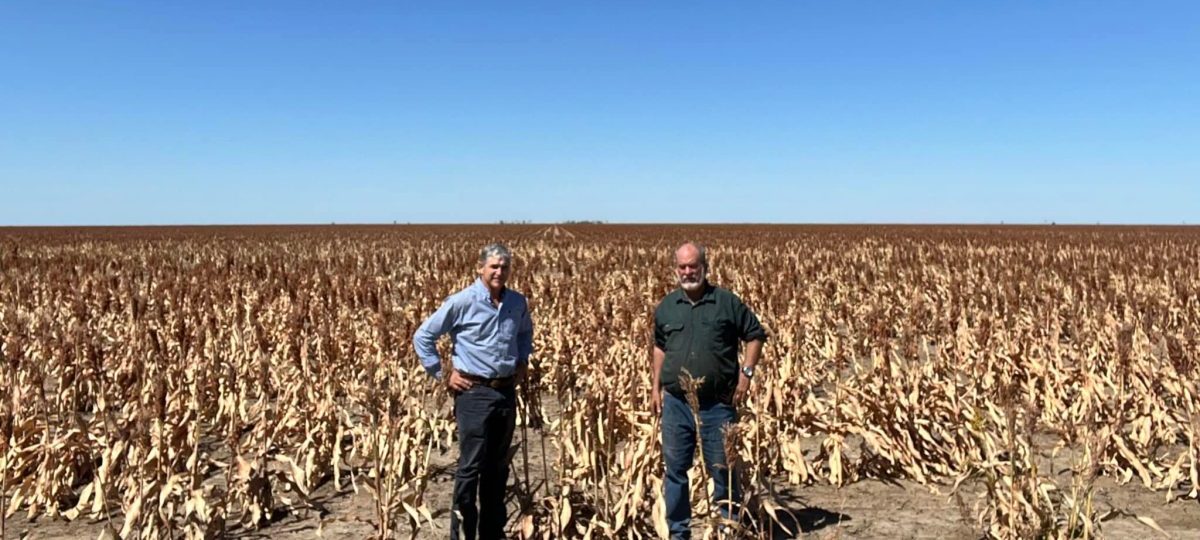
Member for Traeger Robbie Katter and Burketown producer Ernie Camp with Floraville’s first sorghum crop. Photo: Robbie Katter MP
THE first crop of sorghum on the Camp family’s Floraville Station has been harvested and, despite it being subject to a rough time from weather and corellas, it won’t be the last.
While the yield was disappointing, less than 1 tonne per hectare, the exercise yielded around 1250 tonnes of top-grade SOR1, which is destined for export to China.
The crop was the first joint venture between property owner, cattleman and Burke Shire Council mayor Ernie Camp, and sharefarmer Harry Pye.
Based at Cumborah near Walgett in north-west New South Wales, Mr Pye met Mr Camp through a mutual connection.
Mr Pye started his preparations for the maiden sorghum crop in September last year with a Grizzly cultivation, ahead of planting 2250ha in February.
“It was very patchy germination, and no storms to start with, but we got something from the late wet,” Mr Pye said
Around 250ha of the poorest germination was sprayed out, and the rest went through to harvest.
That looked like occurring in June, until 50 millimetres or so of out-of-season rain fell on the crop.
“It was a very weird season; it pushed us back on spraying it out.”
The delay gave corellas the chance to spread word about what could be found at Floraville.
“It let the birds have an extra month on it.
“We were the only sorghum crop in 500 kilometres; the bird pressure was enormous.”
Mr Pye estimates birds took around two-thirds of the grain.
“If we harvested a month before we did, we would have got a much better yield.”
The wisdom of hindsight has been banked for the next crop at Floraville, which will include 1500ha that was cultivated last year but was unable to be sown in February.
Mr Pye said while the average yield of 0.75t/ha “wasn’t brilliant”, it showed that mixed farming is possible in the Gulf.
“We’ve proved that transferring some cattle country to sorghum can be done.”
It’s a similar exercise to the one Mr Pye’s father Harry carried out in decades past at Cumborah, by introducing some cropping to the previously grazing-only district north-west of Walgett.
“There’s no doubt in my mind it’ll take off, but it’ll be baby steps at the start.”
Mr Pye said “the big sweetener” was the reasonably reliable 600mm of annual average rainfall, ideally timed to land on the crop, and the “beautiful soil”.
“It’s heavy grey clay vertosol.”
The soil, which he said could easily make you think you were farming at Mungindi, was already holding moisture for the upcoming plant.
As proof of his belief in the venture, Mr Pye has parked a 24-metre Boss sowing rig with 24 disc units at Floraville.
Other gear, including a New Holland 670 track tractor, is making the trip up and back between the Pye family’s winter-cropping operation at Cumborah, and summer-cropping in the tropics.
The Pyes rarely summer crop at Cumborah, and Mr Pye said farming in the Gulf country provided the opportunity for increased efficiency for their machinery.
“You’re getting twice the work out of your tractors.”
“It is a bit difficult with the development, because we’re turning over more cultivation…but that’s the development side of it.
“It does fit in pretty well with what we do down here.”
Welcome diversification
Ernie Camp said cropping on Floraville was made possible by Mr Pye being prepared to take on the exercise.
“We both believe there’s a great future in cropping, but it would be foolish of me to try to do by myself.
“I’m not a farmer.
“Regardless of nature’s cut, we’ve proven that our ground can produce quality product.”
He said while this year’s crop was no cash cow, it has provided the impetus to keep going, and possibly inspire others in the region.
“It doesn’t cover all the bills, but it goes some way.”
Mr Camp said with the threat of exotic diseases of livestock spreading from South-East Asia, diversification is within the best interests of Gulf cattle producers.
“It’s not a matter of if an exotic disease comes in, it’s more a matter of when.”
He said chickpeas and cotton as well as sorghum were shaping up as options for him and other cattle producers in the area who were looking to diversify.
“I believe that we’ll try and triple the area we put under cropping, and I’m not the only one who wants to give it a go.
“By talking to some of my neighbours, you could very quickly put up a quarter of a million hectares.”
Mr Camp said the next challenge was to achieve an economy of scale by exporting grain out of Karumba rather than Townsville.
“We could be at the front door instead of the back door when it comes to the Asian market.”
He said crops produced locally, including cottonseed from the burgeoning North Queensland cotton industry, could also be value added through the beef industry.
“We have a protein drought in our natural grass for most of the year.”
“What we grow in crops could help us with that.”
Grain Central: Get our free news straight to your inbox – Click here

HAVE YOUR SAY